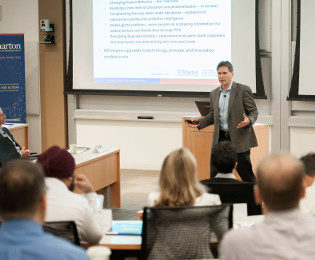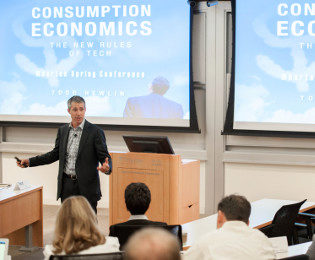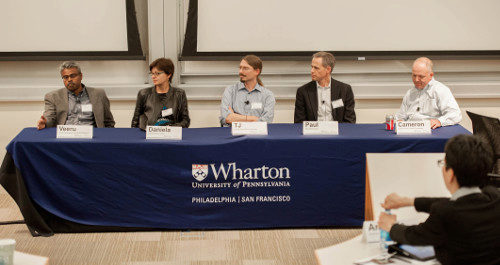Most business leaders are by now vaguely aware that the growing use of mobile phones is changing the competitive landscape for all companies, no matter the industry. The extent of those changes is greater than most appreciate. These changes include entirely new methods of designing products and completely revamped methods for selling them. They also involve a fundamentally reinvented relationship with customers: to be precise, customers are now your bosses.
Those were some of the key ideas that emerged from a conference hosted on May 30th by the Mack Institute for Innovation Management of the Wharton School. The institute is a research community and network for executives, researchers, faculty, and students located on the main Wharton campus in Philadelphia. However, for this conference, the Mack Institute team ventured out to the brand new Wharton campus in San Francisco, located in the renovated former headquarters of Hills Bros. coffee and offering panoramic views of the San Francisco–Oakland Bay Bridge. It was the first time that the institute had left Philadelphia for one of its conferences, which are highly regarded among innovation researchers in both academia and private industry.
The New Platform
The high-stakes nature of the topics being discussed at the conference was evident even in its very title, How Mobile and Social Are Transforming Innovation Models: Flipping the Paradigm? The question mark at the end probably wasn’t necessary, judging by one of the slides shown by Scott Snyder, one of the day’s organizers who is a senior fellow at the institute and president of Mobiquity, one the country’s largest mobile app developers. The slide was jammed with text and had dozens of activities listed on it, everything from shining a flashlight to using a tape measure to turning the air conditioner on and off. What they had in common, Snyder said, was that they were on the constantly expanding list of things people are now doing with their mobile phones.

“The war is over,” Snyder said. “Mobile is the new platform. And it is changing our behavior. We are using it for everything, because we like doing things the easiest way possible.”
There are many implications of this shift to mobile. One, said Snyder, is that the concern about privacy and “masked identity” that was so dominant in the early days of the internet is being changed by social media like Facebook. The new normal is what Snyder called “exposed identity” and constant sharing. Because your phone always knows where you are, one of mobile’s biggest impacts will involve providing “point of inspiration” messages to consumers that attempt to persuade them into a purchase at exactly the moment they’re able to make it.
Snyder predicted several industries and professions were on the verge of being disrupted by mobile. Medicine is a prime example. There are now apps that serve as an “Open Table for doctors,” allowing patients to search for participating local physicians with an opening that same day rather than having to wait a week for a session with their regular doctor.
New Possibilities in the New Economy
Another conference speaker, Todd Hewlin, said the new ground rules in the social and mobile economy were “the perfect storm for disruption,” and the most significant new rule requires that companies learn an entirely new way of selling their products. Hewlin is a managing director of TCG Advisors, a consulting group best known for its association with Geoffrey Moore, author of Crossing the Chasm, one of the all-time best-selling business books. Hewlin himself is a coauthor of Consumption Economics: The New Rules of Tech.
The new way of selling products, Hewlin said, involves a move from what he called the “CapEx” business model to one dubbed “OpEx.” Traditionally, said Hewlin, companies assumed their customers made their purchases with a “capital expenditures” mentality; making a big, one-time purchase and then using the product for many years. Hewlin said there was an “asymmetry of risk” in that arrangement, as customers are often stuck with obsolete products before they have been able to amortize their purchase price.

Another downside to CapEx is that companies get into a vicious cycle of convincing customers to upgrade to a new product by “improving” the old one by adding new features. The results are bloated products full of features most customers never use.
In the OpEx model, customers, in effect, lease rather than buy their products. A number of “software as a service” companies, such as Salesforce.com, have pioneered this approach in the enterprise software market, and Hewlin has predicted it will be spreading to other industries.
One of the main causes of this change, Hewlin said, is the growing power of customers. “Simplicity is going to be the key,” he said. “We have to make products that are so simple that anyone can use them.”
Hewlin chided companies for often not knowing which features of their products their customers are actually using. New, low-cost sensor technologies are making this sort of feedback possible, and Hewlin said companies should take advantage of them to better understand what their customers want. That will help them avoid crashing into the “margin wall” that he said is an inevitable part of the OpEx model, with constantly declining prices and commoditized products.
The Psychology of Social Media
One of the most novel presentations of the day took place not in San Francisco, but 2,500 miles away at the main Wharton campus back in Philadelphia. Kartik Hosanagar, associate professor of information and operations management at Wharton, gave a presentation on new social media research underway by him and his associates.
Hosanagar delivered his presentation via TelePresence technology from Cisco Systems. His talk was streamed live from the East Coast and projected on a large screen in the front of the room in San Francisco. The effect was so lifelike that if you squinted your eyes a bit, you’d have thought he was there in person. The experience was the same on the other end: Hosanagar could see his audience so well that he was able to answer many of his questioners by name because he could read the nameplates in front of them.
The research he described was just as high-tech. Hosanagar’s team is interested in the emerging sociology and psychology of social media; specifically, what prompts people to “like” or “comment on” a Facebook post, especially one from a company. So he built up a computer file containing 106,000 Facebook messages posted by 782 companies over the course of nearly a year, starting in September 2011. Then he took advantage of Amazon’s Mechanical Turk service, which parcels out massive, repetitive tasks to stay-at-home workers (in this case, in the United States).
A subset of the messages was categorized by the Mechanical Turk workers according to criteria developed by Hosanagar’s team. Did the message make some sort of emotional appeal? Did it mention a specific deal on a specific day? Did it urge readers to contribute to a charity? Did it mention a holiday, like Christmas or Thanksgiving? After all of the subset of messages had been scored by humans, the results were turned over to a computer, which, using the latest in “machine learning” technology, used those results to quickly process the remainder of the sample.
The results contained a number of surprises. Unfortunately for many of the retailers trying to drive customers to specific sales events, messages that promoted a particular item didn’t do a very good job of generating “likes” or comments. Neither did those involving holidays.
What did? Emotion, followed closely by philanthropy. Posts that seemed like they were coming from a friend or that urged readers to donate to a certain charity consistently got high scores. The lesson for retailers, said Hosanagar, is that they need to mix up their social communications rather than just blasting out endless messages about deals and products.
During the Q&A segment, several members of the audience pressed Hosanagar on whether all the social media efforts now underway by big companies have any measurable ROI. Hosanagar responded that the medium is still too young to know the answer, although researchers like him are actively pursuing it.
Feeding the Ecosystem
The new mobile and social business models bring challenges and contradictions, many of them summed up by Harbir Singh, co-director of the Mack Institute, Vice Dean for Global Initiatives, and the Mack Professor of Management at Wharton.
Most businesses today understand that they need to exist in an “ecosystem” that includes other companies, some of them competitors. However, Singh said, there is a “constant tension” at companies about the issue. On the one hand, they need to take steps that will nurture and sustain the ecosystem they find themselves in, but on the other hand, in doing so they often find that someone else, perhaps even a rival, is gaining most of the benefits from their contributions.
“You have to feed the ecosystem,” Singh said. “It will die if all you do is extract value from it. But you also have to get your fair share of the benefits.”
The right approach, he said, was one of “joint value creation,” wherein companies take great care to monitor what they are getting out of their business environment compared to what they are putting into it.
Singh said one tactic that many companies use is to open up their products, which makes them a platform that others can contribute to, the way small internet companies sometimes access Google data to use in their products.
Conference attendees also benefited from informative and engaging presentations by Juan-José Juan of Vodafone on the topic of “Social and Mobile: The Rise of the Chief End User,” Anand K. Iyer of WellDoc on “mHealth: Changing the Rules of the Game by mPowering Patients,” and Jay Sullivan of Mozilla on “Open Innovation with A Mission.”

The day also featured a panel of representatives from some of the country’s biggest companies. These panelists discussed the challenges they have faced determining how to maneuver as social and mobile applications continue to become more popular.
Disrupters, Incumbents, and Enablers
In keeping with one of the big themes of the day—involving the growing role of customers—attendees at the conference also made their own contributions. During lunch, they were divided into three groups: “disrupters,” who are bringing about change; “incumbents,” who must adapt to change; and “enablers,” who are providing the tools to make those changes possible. During the salmon and pasta lunch, in addition to the normal lunchtime socializing, they discussed the world from their assigned perspectives; after lunch, each table reported back on what had been said.
Many of the lunchtime rap sessions echoed themes that had been presented by speakers, notably Singh’s dissection of the challenges and opportunities involved in working inside of a business ecosystem.
There were a few standout ideas as well. One table observed that engineers who are using social media tools are often much more productive than coworkers who don’t.
Another standout contribution was by TJ Giuli, research lab leader of Ford’s Silicon Valley Labs. Giuli described a small mobile/social/automotive research project he had undertaken: A car that tweets about how it feels.
It’s not quite as strange as it sounds. Giuli hooked up sensors to the car, like those for acceleration and braking, which then monitored if the driver was on a long, steady drive, in which case the car would tweet that it was in a good mood, or if it was engaging in a lot of shorts stops and starts, then the car would complain about being frustrated.
The project, Giuli said, was done in something of a whimsical spirit and lasted just a few weeks. While Google has been talking about its self-driving car, Ford, he stressed, has no plans to unveil a self-tweeting one.



